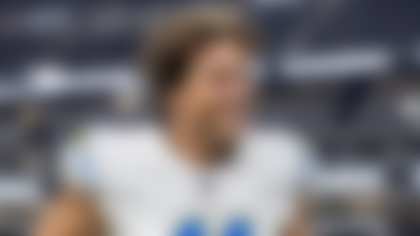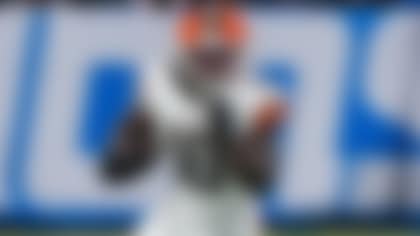As we head into the final game of the 2017 NFL season, Super Bowl LII, Chris Wesseling and Matt Harmon provide their All-Pro teams. Where do Wesseling's seasoned eye and Harmon's Next Gen Stats-based evaluations differ -- and where do they converge?
Quarterback
Chris Wesseling: Tom Brady, New England Patriots. Forget the numbers. High-level quarterbacking in today's version of the NFL is about situational football, spreading the ball around, controlling tempo and attacking the right matchup on the right down and distance. That pinnacle is reached by maintaining the physical abilities of youth long enough to maximize the wisdom accumulated through years of deciphering defenses. To that extent, Brady is the master: half Yoda, half Jedi. If Bobby Layne and Johnny Unitas invented the two-minute drill, Brady has made a science out of the game's most important possessions. As impressive as Carson Wentz was for three months, two respected sources charting every throw by every quarterback -- NFL.com's Gregg Rosenthal and Pro Football Focus -- rated Brady as the cream of the crop by a wide margin this season. Take away the slot receiver, the tight end or the deep threat, shake up the backfield and the offensive line. As long as Brady remains the North Star, the Patriots' hegemony continues unabated.
Matt Harmon: Tom Brady, New England Patriots. It was just another year of excellence for the greatest quarterback to ever take an NFL field. While he hardly needs the words of affirmation, there are layers of them to offer in underscoring just how dominant Tom Brady was in his age 40 season. The future Hall of Famer was under pressure on a league-high 155 pass attempts this season, but it didn't unsettle him in the slightest. Brady's 10 touchdowns and 98.0 passer rating under pressure led all quarterbacks with at least 50 throws this year. As he enters uncharted territory in terms of success level at his age, Brady has yet to offer much reason for hesitation in continuing to project him as one of the best players in the game every year.
Running back
Wesseling: Todd Gurley, Los Angeles Rams. What a difference coaching makes at the highest level of pro football. Gurley experienced a nightmare second season under Jeff Fisher's 2016 staff, setting marks for futility while lashing out at the "middle school offense." Transformed behind an overhauled offensive line, Gurley took advantage of Sean McVay's brilliant play designs and timely calls to carry the league's most improved attack and give a Brady an honest fight for the 2017 MVP award. Reminiscent of Adrian Peterson's furious 2012 finish, Gurley was the NFL's most unstoppable force in December, flashing a Millennium Falcon-like hyperdrive that consistently enabled him to pull away from defenders as a big-play machine. Without benefit of the season finale, Gurley joined Hall of Famers O.J. Simpson and Marshall Faulk as the only players ever to hit 2,000 scrimmage yards with at least 10 rushing scores and six receiving touchdowns in one season.
Harmon: Todd Gurley, Los Angeles Rams. The ultra-talent of Todd Gurley was released from the shackles that kept it out of sight during the Rams' 2016 season. Beyond Gurley's raw rushing skills, the most notable change in his game was the way Sean McVay found creative outlets to exploit the running back's explosive abilities in the pass game out in space. Passes sent in Gurley's direction this season traveled an average of 1.8 yards downfield. Yet, the dynamic back averaged an eye-popping 12.3 yards per reception, showing just how much damage he did with the ball in his hands after the catch.
Wide receivers
Wesseling: Antonio Brown, Pittsburgh Steelers; DeAndre Hopkins, Houston Texans. As impressive as Bell was down the stretch, Brown seemed to single-handedly carry Pittsburgh's offense for large sections of the season. After slicing and dicing Tennessee's secondary in one of the dominant performances of the season, Brown carried the Steelers to victory with superhuman game-altering catches versus the Packers, Bengals and Ravens in each of the next three weeks. He just posted a five-year stretch statistically superior to any such half-decade span in the careers of future Hall of Famers Randy Moss and Calvin Johnson. The NFL's premier boundary receiver, Hopkins was a one-man show in Houston, giving top cornerbacks fits no matter the newcomer under center. No play better encapsulated his rare ability more than the Christmas Day miracle touchdown -- an incredible act of prestidigitation incorporating sleight of hand, balletic footwork, gymnastic balance and a contortionist's ability to twist his body into the confined space at the corner of the end zone.
Harmon: Antonio Brown, Pittsburgh Steelers; DeAndre Hopkins, Houston Texans. Brown and Hopkins set the standard for wide receiver play this season. These two are special players because they make difficult catches look routine while excelling in tight quarters. Brown (10 for 229) and Hopkins (13 for 226) were the only receivers to post double-digit catches and over 200 yards on "boundary targets" (within 1 yard of the sideline) this year. Julio Jones finished third in the yards department there, with almost a full 100 yards (130) fewer than those two.
Flex
Wesseling: Le'Veon Bell, Pittsburgh Steelers. Pittsburgh's 2017 ground attack never reached the "flawless synchronicity" that drove Bell to unprecedented heights the year before. The Steelers' underperforming offense entered November as one of just a handful yet to reach 30 points in a game. Starting with the second-half explosion versus the Titans in Week 11, Bell re-emerged as the dual-threat focal point, averaging 152 yards on 25 touches over a five-game stretch as the offense finally fired on all cylinders. It's easy to see why the impending free agent wants to be paid as a No. 1 running back *and* No. 2 receiver. He's been the NFL's preeminent backfield force over the past four seasons.
Harmon: Alvin Kamara, New Orleans Saints. Kamara proved to be a transformative figure in the Saints' offense. His work as a receiver embodies the new NFL trend to have running backs who are true weapons -- not just assets -- in the passing game. However, Kamara was such a unique entity because he was also the most difficult back to bring down as a pure runner. Kamara led all RBs with at least 100 carries by gaining an extra 4.74 yards after defenders closed within 1 yard of him this season. He broke tackles at will and exhibited truly special ability throughout his rookie campaign.
Tight end
Wesseling: Rob Gronkowski, New England Patriots. The first NFL tight ends were offensive linemen sneaking outside for the rare reception in the pre-television days before Bears legend George Halas split Mike Ditka out wide as a new breed in 1961. As Cardinals general manager Steve Keim noted a few years ago, modern tight ends tend to be limited players who fall into one of two categories: overgrown wide receivers struggling with blocking chores at the point of the attack or inline blocking specialists lacking the skill set to threaten defenses as effective pass catchers. Gronkowski is the exception to dichotomy, custom-built by the gridiron gods to stand as the evolutionary Mark Bavaro. Gronkowski authored an astounding five-play sequence to swing the AFC's biggest regular-season game of the year, standing as gold standard for his position. The greatest tight end in history is more important than ever to the greatest quarterback in history.
Harmon: Zach Ertz, Philadelphia Eagles.Travis Kelce and Rob Gronkowski also offered up seasons worth the nod here, but Ertz takes home this spot in what was easily the best and most consistent season of his five-year career. Eagles quarterbacks had a 130.8 passer rating when targeting Ertz in tight windows (less than 1 yard of separation). That ranked second among tight ends with more than one tight-window target this year, ironically trailing only his teammate, Trey Burton (138.5).
Tackles
Wesseling: Andrew Whitworth, Los Angeles Rams; Lane Johnson, Philadelphia Eagles. It's only fitting that Whitworth stands as a fine fallback choice in a season that saw a string of stalwart blind-side protectors such as Joe Thomas, Jason Peters, Tyron Smith and Trent Williams bitten by the injury bug. Before he gained long-awaited notoriety for the Rams' historic turnaround, Whitworth was rarely recognized for his All Pro-caliber play over a decade in Cincinnati. Carson Wentz's extended rookie-year slump coincided with Johnson's 10-game absence due to suspension. With Johnson back in the lineup, Wentz emerged as a surprise MVP candidate while the Eagles unleashed a relentless ground attack.
Harmon: Andrew Whitworth, Los Angeles Rams; Ryan Ramczyk, New Orleans Saints. Whitworth was perhaps the most impactful free-agent signing in the NFL this season, proving to be a key figure in the Rams' offensive revival. Back in 2016, Todd Gurley averaged -0.1 yards before a defender closed within a yard of him. The 2017 version of Los Angeles' blocking afforded running backs 0.65 yards before close, ranking third-best. Ramczyk stepped up when called upon and excelled at both tackle spots on what was one of the NFL's best lines. Saints running backs averaged a league-high 0.87 yards gained before defenders closed within 1 yard of them, leading the league by a wide margin and demonstrating New Orleans' run-blocking prowess. The Saints also allowed the fewest pressures (108) in the league. Fine rookie season for the last pick of 2017's first round.
Guards
Wesseling: David DeCastro, Pittsburgh Steelers; Zack Martin, Dallas Cowboys. With apologies to the Rams' Rodger Saffold and Panthers' Andrew Norwell, these two former first-round picks deserve the nod. DeCastro was a picture of reliability in Pittsburgh, opening holes for Bell and overcompensating for the instability at right tackle. A technique master, Martin has been the NFL's premier guard since the day he entered the league out of Notre Dame four years ago. While Ezekiel Elliott's suspension contributed to the Cowboys' November skid, it's to the credit of Martin and sterling center Travis Frederick that veteran power back Alfred Morris saw little drop-off in effectiveness as the stand-in starter.
Harmon: David DeCastro, Pittsburgh Steelers; Joel Bitonio, Cleveland Browns. DeCastro was as steady as they come all season and the premier player on a line that proved, once again, to be among the best units in the NFL. Pittsburgh ranked 11th in average rushing yards gained before defenders closed within a yard (0.35) and sixth in pressure rate allowed (21.7 percent). Bitonio is one of the many young core players on Cleveland's roster who goes unnoticed due to the team he plays for. The Browns' remade offensive line allowed Cleveland backs the fifth-highest average in rushing yards gained before defenders closed within 1 yard (0.58). There is fertile soil to grow a running game in Berea, should the coaching staff ever commit to it.
Center
Wesseling: Jason Kelce, Philadelphia Eagles. There's no other center like the undersized Kelce, an athletic pivot who gets downfield in a hurry to control Philadelphia's lethal screen-pass game. While Doug Pederson certainly deserves plaudits for his uncanny scheming and play-calling, Kelce is the irreplaceable keystone to Philadelphia's chain-moving rushing attack. Dallas' Travis Frederick and Atlanta's Alex Mack were in Kelce's class, as well.
Harmon: Travis Frederick, Dallas Cowboys. Some of the turnover and injuries on Dallas' offensive line caused the unit to take an overall step back in 2017. The team ranked just 20th in average yards gained by rushers before defenders closed to within 1 yard (0.2). Despite some turmoil around him, Frederick remained the rock and anchor of the line at center. He particularly stood out as a pass protector. The Cowboys allowed just two pressures right up the middle of their offensive line, tying with Tennessee for the second-fewest.
Kicker
Wesseling: Greg Zuerlein, Los Angeles Rams. Baltimore's Justin Tucker has set a new standard for long-distance expectations over the past two years, but Zuerlein's 2017 production can't be ignored. A lock to shatter David Akers' single-season record for most points by a kicker (166) had he remained healthy, Zuerlein still led the league in scoring (158 points) despite missing the last two games due to a herniated disc injury.
Harmon: Greg Zuerlein, Los Angeles Rams. The Rams kicker was an edge for the team this year and enjoyed his best season as a pro. Zuerlein cranked in all but one of his attempts from 40-plus yards out and nailed 95.7 percent of his kicks overall. His December trip to injured reserve sent fear and paranoia into the hearts of Rams fans, especially when his replacement missed both a field goal and extra point in his first start.
Returner
Wesseling: Pharoh Cooper, Los Angeles Rams.Cordarrelle Patterson and Tyreek Hill might be more exciting talents, but Cooper finished second in both kickoff- and punt-return yards as the game's most dangerous big-play returner. It's a testament to coaching guru John "Bones" Fassel that the Rams' special teamers reign on this list.
Harmon: Tyler Lockett, Seattle Seahawks. The Seahawks are still waiting for Lockett to fully emerge as a wide receiver, as he wasn't a full-time player this year after recovering from a broken leg to end 2016. However, he was a dynamic return artist in 2017. Lockett cleared 18 MPH on six returns this year in addition to doing so thrice on offense. His top highlight came on a 99-yard kick-return touchdown where Lockett hit 20.39 MPH and traveled 115.85 yards of raw distance.











